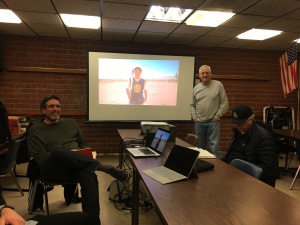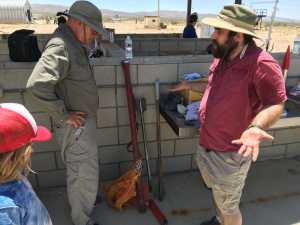The RRS met for its monthly meeting, Friday, January 12, 2018, at the Ken Nakaoka Community Center in Gardena. We got a late start (8:04pm), but we covered a lot of ground.
Everyone is reminded that the anniversary issue of the ASTRO-JET newsletter of the RRS is now available for $10 a copy. This special issue will be available in print only and proceeds go to benefit the society and our upcoming symposium event. Bill Janczewski and I have worked hard to bring this milestone issue together and we will have them ready for printing and distribution next week. To order, you can contact me by email (secretary@rrs.org) and send me your mailing address. Payment can be made by check to the “Reaction Research Society” sent to our P.O. Box 90933, in Los Angeles, CA, 90009-0933, found on our website.
Payment to the RRS for the ASTRO-JET newsletters can also be made by clicking our “DONATE” button on the website which directly links to our Paypal site. Please note your are paying for the ASTRO-JET and the number of copies.
Frank brought one of George Dosa’s liquid rocket chambers to the meeting for inspection by the society. This single element coaxial injector has not been fired, but George had this made several decades ago. There was talk about what modifications could be made to get this article into hot fire.
Richard Garcia also brought his own liquid rocket chamber as part of the on-going RRS standard liquid rocket project he has been championing.
After the usual reading of the treasury report, we began to discuss the agenda topics. The meeting began with announcing our new members who have recently joined us: Michael Lunny, Bryan Calungcagin, Nancy Squires, Barsoum Kasparian and Jack Oswald. The RRS is glad to welcome our new members.
The discussion had turned to membership cards. Bill Janczewski has worked up a new card design and Frank was working with Bill on a few changes. The RRS does not issue membership cards except on an on-demand basis. RRS member, Alastair Martin who runs a printing business had several ideas for different types of card stocks and discussed them with the RRS.
Larry Hoffing had asked about getting a short run of business cards to support his role as the RRS events coordinator. Frank had said he has the resources to get these made.
Our discussion then turned to the upcoming RRS symposium to be held Saturday, April 14, 2018. We will try a new format of having our speakers present in the ballroom among our exhibitors. The collared white shirts we gave to our membership running the event was a good idea. We discussed getting these again with iron-on or screen-printed RRS logos to help identify those of us who will be running the event. Frank wanted to have posters showing a decade-by-decade look of the RRS over our 75 year history. This is a great idea and we’ll be working hard to collect old photos to have them on display at the symposium. Easels and other supporting equipment were in short supply as the brick walls of the Ken Nakaoka Community Center made wall-mounting very difficult.
For next meeting, we will discuss more of the details of the symposium including working on our list of presenters and exhibitors. Frank and I have already began to approach some of our prior speakers and exhibitors. We have already confirmed several from industry, government and academia including the LAPD CSP program and the Aerospace Corporation. We expect this year’s symposium to be even greater than last year’s event where we hosted over 200 people.
For the next agenda item, Frank and Larry will begin our next educational event with the students of Florence Joyner Elementary school in conjunction with the LAPD CSP program. This 5-week event will begin sometime in February with an expected launch event in late March. Alastair had indicated he’d like to participate, film and document this event. An update on this event will be given at the next month’s meeting.
Michael had indicated his interest in running an RRS educational event with his old high school, Redondo Union High School. Larry and Frank had offered to help him figure out how best to set this up based on the experience the RRS has had thus far. I had sent him the PowerPoint file I had made which can serve as the basis for the program he can give to an older group of students. This would be the first of several events that Michael and Bryan would like to hold on behalf of the RRS.
Our next agenda topic discussed establishing an account with the regional liquefied natural gas (LNG) supplier, Clean Energy in Boron, California. Richard Garcia has acquired a methane dewar which will be used for liquid rocketry experiments at the MTA. Richard was able to have one of our contacts at the Friends of Amateur Rocketry (F.A.R.) group modify the dewar such that it is ready for use. Our president, Osvaldo, said he would contact Clean Energy and give them the necessary information for the RRS to begin buying quantities of methane.
The next agenda topic was the quarterly briefing of the SuperDosa project. Osvaldo and I have identified chemical suppliers to produce the RRS standard solid propellant mixture recipe. We will meet offline to discuss prices and what is the best approach to proceed. Richard was going to work out some more simulations of our proposed vehicle to get an idea for sizing. The ballistic evaluation motor (BEM) that I designed is still in work. This is an important piece of hardware to characterize the burn rate of our propellant to help finalize and set the grain design. I hope to complete the assembly before the symposium which would also be the next quarterly reporting date (April 13, 2018).
The last agenda item was to discuss how to formalize the proposal process for RRS projects that we would like to seek funding from outside groups. One of the most important things to getting projects funded is to have a clear plan on what the scope of the project is, what purposes it will serve, what exact materials and quantities will be required and what the expected cost of this project will be using real quotes and defensible estimates. The RRS was in agreement and the executive council will meet later to discuss some of these documented proposals I have assembled. Projects include things like making more alphas and beta rockets, 3D printer for RRS use, spare electric generator for the MTA, getting a new launch rail built as backup, obtaining a liquid oxygen dewar…. etc.
The night ran late and our meeting concluded at 9:10pm.
There’s a lot of preparation that must be done in advance of our 75th anniversary symposium on Saturday, April 14th, so we’ll be putting this recurring item on the agenda for next month’s meeting.
For next month’s meeting, Frank will finish his paper rocket air launcher device that he has been making. This was inspired by the last educational event with Grape Street Elementary where the students visited the Space and Missile Command Center at Los Angeles Air Force Base in El Segundo, CA. With luck, we hope to demonstrate it outside the community center and take some video for our YouTube channel.
YouTube – Reaction Research Society
Also, for next month’s meeting, I had promised Frank and Osvaldo that I would bring in my alpha parachute assembly that I have worked into a PVC payload tube. I have resolved some of the issues with my timer circuit, but I am still looking for access to a 3D printer to produce my internal umbilical switch mount.
As always, if there is anything here I have missed or misstated, please let me know. Our next monthly meeting will be held, Friday, February 9, 2018. Hope to see you there.
secretary@rrs.org






































